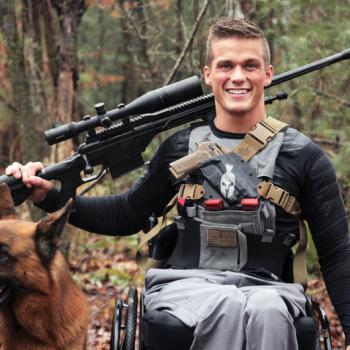Last week an Ohio state senator introduced S.B. 248, a bill designed to prevent homeschooling from being used to hide child abuse. HSLDA responded predictably. It is true that this particular bill, which has already been withdrawn, went too far. It would have required the name of each homeschooler to be run through a statewide child welfare information database to flag those with a concerning history of social services investigations, which is good, but it would have also required each parent and child to have interviews with social services before beginning to homeschool.
But what I find troubling is that HSLDA refuses to admit that bills like this seek to address a real problem and is apparently completely ignorant of the fact that they themselves have helped create this problem. And that is what I want to address here.
S.B. 248 was introduced at the request of Shawn Tedesco, father of Teddy Foltz-Tedesco, a homeschooled boy was beaten to death by his mother’s boyfriend last January. Throughout their response to the bill, HSLDA placed the blame for Teddy’s death entirely on social services.
What happened to Teddy Foltz-Tedesco is a tragedy that could have been prevented. If those responsible for investigating child abuse had done their job, Teddy might have been saved. The system needs reform, but Senate Bill 248 will increase the load on social workers by requiring them to investigate all families who want to homeschool rather than focusing resources on parents actually suspected of child abuse.
I should note that Shawn Tedesco is also asking for reforms of social services, and has never said that homeschooling was the sole cause of Teddy’s death. So, yes, social services could have done its job better. But you know what? HSLDA jumping on the “social services should do its job” bandwagon is extremely ironic. Quite simply, I have yet to read a single case where HSLDA did not try to get in the way of a child abuse investigation. In fact, they not only ward off social workers from the homes of their members even when the charges have nothing to do with homeschooling, they also take on and represent parents in specific child abuse or neglect cases in order to set precedent limiting the ability of social services to do their job.
I’ve written before about HSLDA’s Fight against Child Abuse Reporting, HSLDA’s Stonewalling of Child Abuse Investigations, and even HSLDA’s Defense of Child Abuse. In fact, HSLDA has been so committed to hamstringing social services that a legal comment published in UMKC Law Review in 2004 was titled “Standard Bearers of the Fourth Amendment: The Curious Involvement of Home School Advocates in Constitutional Challenges to Child Abuse Investigations.” This article gives a good overview of Michael Farris’s view of social services, and I’ve written before about Michael Farris and child abuse denialism. Indeed, HSLDA is on record campaigning for the elimination of the anonymous tip and the criminalization of false reporting.
So let me ask this: What is HSLDA saying should have happened in the case of Teddy Tedesco? Their response says that “those responsible for investigating child abuse” should have “done their job.” What are they referring to? Well, Teddy was pulled from school to be homeschooled after teachers reported his abuse. HSLDA is saying that social services should have effectively investigated those reports, and that if they had they would have discovered Teddy’s abuse. Well, from what Teddy’s father says on his website, it appears that social workers did attempt to investigate Teddy’s teachers’ reports of abuse:
We would like to ensure that there are no longer appointments being made when children services responds to a case. In addition if no contact is made by the second visit we would like to see a search warrant being issued to enter the home.
In other words, it appears that Teddy’s mother and her boyfriend denied social services entry to the home. It also appears that social services attempted to make appointments to meet with the family rather than coming unannounced. One of HSLDA’s big crusades in the past several decades has been to prevent social services access to families’ homes under the banner of fourth amendment rights. The argument is that if there is actually abuse taking place, social workers should be able to obtain enough evidence to get a warrant without entering the home. But how is this going to happen in the case of a homeschooled child who is being isolated and abused? How does one find corroboration of abuse if abusive parents have used homeschooling to remove a child from contact with relatives, neighbors, and teachers?
Let me put it like this: If Teddy’s mother had been an HSLDA member, and had she called HSLDA to report that there was a social worker at the door, an HSLDA attorney would have coached her through denying social workers access to the home and denying social workers any request to speak with Teddy alone. In other words, HSLDA would have coached them through taking the exact same actions they took on their own, presumably without HSLDA involvement. I know HSLDA would have done this because I’ve read case after case when they’ve done exactly this, and it’s not like they conduct a child abuse investigation of their own before they offer legal advice and intimidate social workers into dropping the case.
And yet, even as the organization does everything in its power to limit social workers’ ability to investigate and intervene, this scapegoating of social services is par for the course for HSLDA. When four homeschooled children were murdered by their mother in 2008, the New York Times reported that:
Officials at the Home School Legal Defense Association, in Purcellville, Va., acknowledge that children schooled at home, as Ms. Jacks said hers were, are in rare instances the victims of abuse. But such cases generally occur in families already known to law enforcement or social service agencies who may have “missed the signs and signals,” said Ian M. Slatter, a spokesman for the association, and “being in school wouldn’t all of a sudden make those children safe.”
Yes, being in school doesn’t make children safe from child abuse, but it does put children in contact with people who may notice and report their abuse and provide them with access to help should they be able to speak out about their abuse. I do not understand why HSLDA cannot publicly admit that homeschooling can be used to isolate a child and conceal child abuse.
I’ve written here before about the way homeschooling can be used to conceal child abuse, and groups like Homeschooling’s Invisible Children, the Coalition for Responsible Home Education, and Homeschoolers Anonymous also address this problem. Here’s an example:
Mitch Comer was removed from school after the eighth grade to be homeschooled by his mother and stepfather, Sheila and Paul Comer, who proceeded to imprison in his room and abuse him. On his eighteenth birthday, his parents bought him a one-way bus ticket to Los Angeles, gave him pamphlets for homeless shelters there, and threw away all reminders of him. He was found wandering the streets of Los Angeles. He was so malnourished that police thought he was a preteen child. The teen’s skin was translucent and his abuse had grown so bad that he had seen neither sunlight nor his younger sisters, who lived in the same home, in the past two years. Mitch’s sisters were removed by social services and his parents were arrested, tried, and sentenced to fifteen years in prison. The family’s neighbors were shocked when they learned that a teenage boy had lived in the home.
Would HSLDA really refuse to admit that homeschooling played a role in Mitch Comer’s abuse? Really? Yes, Mitch Comer would likely have been abused even had he continued to attend public school. But he would not have been locked in his room without ever seeing the sun for two straight years had he been attending public school—and, had he attended public school, he would have had someone he could go to about his abuse. Indeed, for some abused children, public school provides a safe haven, an island of normalcy with people who care. But not for Mitch Comer. Further, how was social services to discover this boy’s abuse? He was so isolated that the neighbors did not even know that a teenage boy lived in the home. How, then, were they to report his abuse? That homeschooling played a role in concealing Mitch Comer’s abuse is beyond objection. And yet, HSLDA simply cannot or will not admit this.
Do you know what else really gets me? HSLDA’s insistence that if social services was previously involved with a family in some form, they must magically know if the family is homeschooling and abusing their children. This makes no sense at all. If there are previous unsubstantiated reports of abuse, or if there is a previous open case that has since been closed, there is no ongoing social services involvement. Take this case, for example:
Police found 10-year-old Emani Moss’s burned body in a trash can several days after she was starved to death at the hands of her father and stepmother, Eman and Tiffany Moss. After a tip from a school employee, social services had intervened in Emani’s family three years earlier, removing her from her parents’ home for a brief period in early 2010. Two individuals, presumably Emani’s father and stepmother, were required to take anger management courses and Emani was returned to the home on social services’ determination that the risk of harm was reduced. Emani’s case was closed in November of 2010. In May 2012, school officials reported welts that were found on the girl, but social services determined the marks were the result of legal corporal punishment. That summer Emani’s parents withdrew her from school to homeschool her, and the girl was not seen again by either school officials or her relatives.
HSLDA would probably blame this case, too, on social services, as they always do—after all, there was previous social services involvement! But this completely misses the point—when there is no open case, it does not matter that there was previous social services involvement, there is no current social services involvement.
Emani’s story brings us back full circle. HSLDA would probably argue that social services should have permanently removed Emani from the home during its current involvement with the family. After all, there was clearly real and systemic abuse taking place, and social services left the girl in the family. There was also the report of marks on the girl only a few months prior, and social services could have possibly helped Emani at that point. But to pin this on social services, HSLDA would have to either argue that social services should put less emphasis on keeping families together or that there should be a more narrow definition of legal corporal punishment.
HSLDA argues that if there is real and true abuse taking place, social services should take the children permanently, and if there isn’t real and true abuse taking place, they shouldn’t actually investigate. It’s this weird bifurcation that completely misunderstands the actual nature of child abuse and the actual role of social services, which frequently works to heal at-risk families rather than simply either removing children or not being involved at all. In taking this position, HSLDA also ignores its own role in preventing social services from conducting the effective investigations that could actually determine whether or not child abuse is occurring in the first place.
And so we find HSLDA outraged that anyone would attempt to prevent abusive parents from homeschooling and quick to pin all of the blame for Teddy’s death on social services. And so we find HSLDA unwilling to acknowledge either the role its own policies played in making it harder for social services to access Teddy or the role homeschooling can play in concealing and perpetuating abuse. I have nothing left to do but shake my head.














